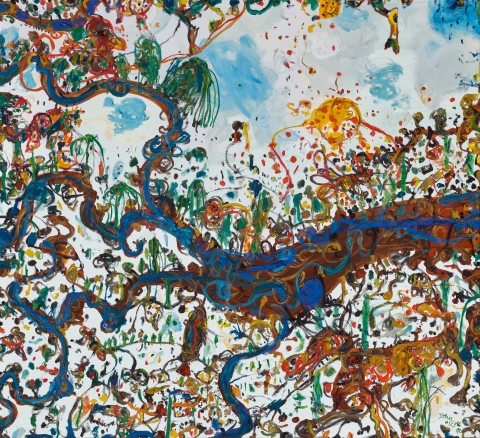SMALL STREAMS RUNNING INTO A BIG RIVER, 1990
JOHN OLSEN
oil on canvas
135.5 x 151.0 cm
signed and dated lower right: John / Olsen / 90
Australian Galleries, Melbourne (label attached verso)
Tolarno Galleries, Melbourne
The National Australia Bank Art Collection, acquired from the above in November 1990 (label attached verso)
National Australia Bank Collection: Rivers in Australian Art, Heide Park and Art Gallery, Melbourne, October 1991
The National Australia Bank Art Collection: Rivers in Australian Art, Heide Park and Art Gallery, Melbourne, 1991, p. 7 (illus.)
Hailed as Australia’s greatest living artist, John Olsen – who is now in his early nineties – has lived a life of intense creativity, and the pleasure he finds in the world around him is palpable throughout his work. The landscape has been a primary subject, from the You Beaut Country series of the mid-1960s which captured the unique nature of Australia in compositions characterised by lively line and vital colour, to depictions of Kati Thanda/Lake Eyre the following decade, more austere but still teeming with life and incident. Striving to express the experience of the complete landscape in his pictures, Olsen explained, ‘... I also wanted to really come to terms with the experience of a total landscape. Not like there is the foreground, there is the middle distance and there is the horizon. I wanted that overall feeling of travelling over the landscape. There you can see the dry creek beds, the nervous system… which when you are just on the ground you don’t witness at all. Then you begin to somehow see the wholeness… It’s more than the present, it’s the past and projects itself into the future.’ 1
In Small Streams Running into a Big River, 1990, a series of vivid blue lines meandering across the canvas depict the river and tributaries of the title. This dancing, calligraphic line emerged early on in Olsen’s career – and has remained a key element of his pictorial language – growing out of Paul Klee’s notion of drawing as ‘taking a line for a walk’. Olsen extended the concept however, taking his line – whether drawn or painted – on a walk through the landscape and using it to record the experience of being in the natural environment rather than just looking at it.2 Olsen’s imaging of the landscape acknowledges the diverse habitats which are incorporated within it and he represents plants, animals and insects as vital elements of a complex and interconnected whole. Here, alongside the various watercourses and their riverbanks, we see a variety of plants painted in rich shades of green, and a visual cacophony of other dots, daubs and squiggles which express the living energy of this environment. Although he adopts a bird’s-eye view to depict the river and streams, beyond their boundaries we seem to be looking up, towards the open sky, in a complex composition that defies expectations of pictorial logic.
Olsen’s fascination with the natural world in all its myriad forms has sustained a creative practice that now spans more than seven decades. His distinctive style of exuberant mark-making, combined with a mastery of colour, have charted the countryside, the coast, deserts and even the city, in images which reflect a strong sense of place and a distinctly Australian sensibility. His contribution to Australian art has been widely acknowledged, from the Wynne Prize for landscape painting, awarded in 1969 and 1985; the Sulman prize in 1989; the Archibald in 2005 – for Self-portrait, Janus faced – and major exhibitions devoted to his art, most recently, the retrospective exhibition shown in Melbourne and Sydney in 2016 – 17.
1. Hurlston, D., & Edwards, D. (eds.), John Olsen – The You Beaut Country, National Gallery of Victoria, Melbourne, 2016, p. 10
2. See Hart, D., John Olsen, Craftsman House, North Ryde, 2000, p. 38
KIRSTY GRANT
